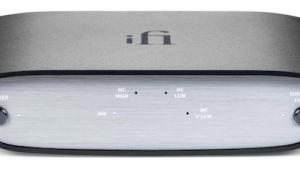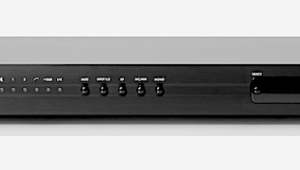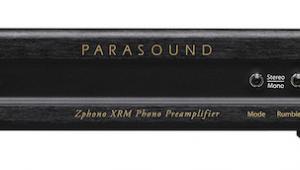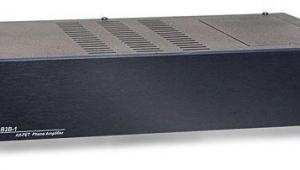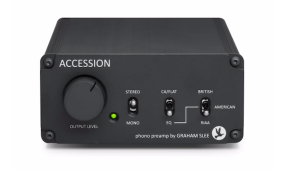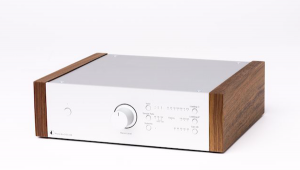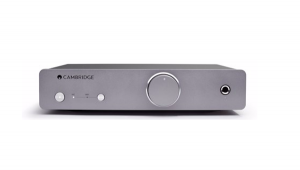Michael, I know it's apples versus oranges, but that's real life after all. Having now auditioned both the JC-3 and the Manley Chinook, how would you constrast the two? I'm not asking you to tell which one is better, just help me to understand how they are different. If context helps, I have a VPI Classic 3 with Te Kaitora Rua and listen to jazz with some classic rock and indie thrown in. Classical when in a mood. Favorite albums include (the Tone Float) In Absentia, Jazz at the Pawnshop, Into the Labyrinth. Looking to upgrade the phono stage of my Perseus Magnum ... intrigued by staying tubey but addicted to macrodynamics.
Parasound Halo JC 3 phono preamplifier Measurements
I measured the Parasound Halo JC 3 with Stereophile's loan sample of the Audio Precision SYS2722 system (see the January 2008 "As We See It" and www.ap.com). The voltage gain measured at the balanced outputs was both higher than specified and on the high side in absolute terms, at 57.4dB moving-magnet and 77.4dB moving-coil. The level from the unbalanced jacks was exactly half these figures, as expected. Both balanced and unbalanced outputs preserved absolute polarity (ie, were non-inverting), meaning that the XLR jacks are wired with pin 2 hot. The input impedance in the "MM, 47k" and "MC, 47k" settings was 45k ohms at low and middle frequencies, dropping to 39k ohms at 20kHz. In "MC, 100 ohms" mode, the input impedance was 100 ohms across the audioband. The output impedance was to specification at all audio frequencies, at a low 100 ohms unbalanced and 200 ohms balanced.
RIAA equalization was superbly flat in the right channel, with just a very slight lack of lower-midrange energy (fig.1, red trace), but the left channel (blue) had a +0.3dB positive error in the treble and a –0.3dB error in the lower midrange. Channel separation (not shown) was both superb and better than the specification, at 90–100dB L–R and 75–190dB R–L. As with John Curl's legendary Vendetta phono preamplifier, the Halo JC 3 was superbly quiet. The wideband, unweighted signal/noise ratio, measured with the input short-circuited, was 78dB (MM) ref. 1kHz at 5mV, and 67dB (MC) ref. 1kHz at 500µV. Switching an A-weighting filter into circuit improved these figures to 86.9dB for both MM and MC modes.

Fig.1 Parasound Halo JC 3, response with RIAA correction (left channel blue, right red; 1dB/vertical div.).
With the high gain, the JC 3's overload margin was a little lower than the best-performing preamps, at 15.5dB at 20Hz and 1kHz in both modes, and 15dB at 20kHz. (These margins were again referred to 1kHz at 5mV, MM; and 1kHz at 500µV, MC.) However, the balanced output level at 1% THD+noise, which I define as "clipping," was 20.8V, which is well above the maximum input level of many line preamplifiers.
At typical recorded levels the Halo JC 3 was essentially distortion-free (fig.2), though some very low-level supply-related spuriae can be seen in the right channel (red trace). I had to raise the input level at 1kHz to 15mV in MM mode to bring the distortion harmonics out of the noise floor (fig.3), though even then, those harmonics were the second at –107dB (0.0005%) and the third at –118dB (0.00013%), which would be subjectively innocuous at levels 100 times higher. The left channel was even better in this respect! Only when I loaded down the balanced output with the punishing 600 ohm load and increased the input level to 18mV did a regular series of distortion harmonics appear (fig.4), but even then, all harmonics remained at or below –80dB (0.01%). This preamp will be superbly linear under all real-world conditions. It also performed equally well with the demanding high-frequency intermodulation test (not shown).

Fig.2 Parasound Halo JC 3, MM, spectrum of 1kHz sinewave, DC–10kHz, at 3.7V into 100k ohms (left channel blue, right red; linear frequency scale).

Fig.3 Parasound Halo JC 3, MM, spectrum of 1kHz sinewave, DC–10kHz, at 11.1V into 100k ohms (left channel blue, right red; linear frequency scale).

Fig.4 Parasound Halo JC 3, MM, spectrum of 1kHz sinewave, DC–10kHz, at 10V into 600 ohms (left channel blue, right red; linear frequency scale).
Looking back through this report, I seem to have used the word superb several times, and justifiably so: The Parasound Halo JC 3's measured performance is indeed superb.—John Atkinson
- Log in or register to post comments






